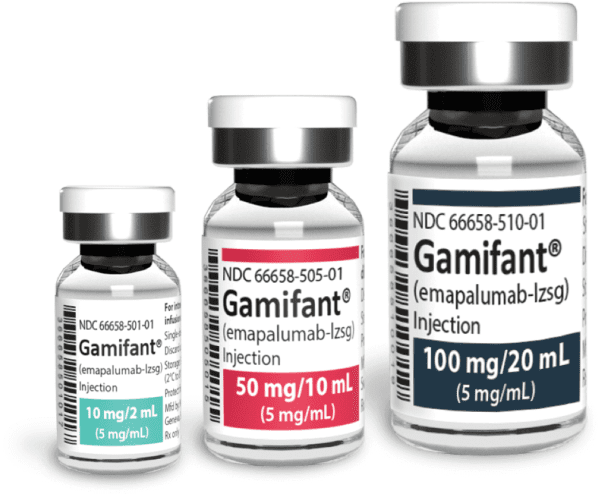Emapalumab Side Effects
Medically reviewed by Drugs.com. Last updated on Feb 23, 2025.
Applies to emapalumab: intravenous solution.
Precautions
It is very important that your doctor check your or your child's progress closely while receiving the medicine and at regular visits to make sure this medicine is working properly. Blood tests may be needed to check for unwanted effects.
You or your child will need to have a skin test or blood test for tuberculosis before you start receiving this medicine. Tell your doctor if you or anyone in your home has ever had a positive reaction to a tuberculosis skin or blood test.
Call your doctor right away if you or your child start to have a cough that would not go away, weight loss, night sweats, fever, chills, flu-like symptoms (eg, runny or stuffy nose, headache, blurred vision, or feeling generally ill), painful or difficult urination, or sores, ulcers, or white spots in the mouth or on the lips. These may be signs that you have an infection.
You should not receive live or live attenuated vaccines during treatment with emapalumab-lzsg and for at least 4 weeks after the last dose.
This medicine may cause infusion-related reactions, which can be life-threatening and require immediate medical attention. Tell your doctor right away if you start to have a fever, chills or shaking, dizziness, trouble breathing, itching or rash, lightheadedness, or fainting after receiving this medicine.
Serious side effects of emapalumab
Along with its needed effects, emapalumab may cause some unwanted effects. Although not all of these side effects may occur, if they do occur they may need medical attention.
Check with your doctor or nurse immediately if any of the following side effects occur while taking emapalumab:
More common side effects
- agitation
- back pain
- black, tarry stools
- bloating or swelling of the face, arms, hands, lower legs, or feet
- bloody stools
- blurred vision
- chest pain, discomfort, or tightness
- chills
- confusion
- cough
- decreased awareness or responsiveness
- decreased urine
- depression
- difficult or labored breathing
- dry mouth
- fast, pounding, or irregular heartbeat or pulse
- feeling of warmth
- fever
- headache
- hoarseness
- hostility
- increased thirst
- irritability
- lightheadedness, dizziness, or fainting
- loss of appetite
- loss of consciousness
- lower back or side pain
- mood changes
- muscle pain, cramps, or twitching
- nausea
- nervousness
- nosebleed
- numbness or tingling in the hands, feet, or lips
- painful or difficult urination
- pounding in the ears
- rapid weight gain
- rapid, shallow breathing
- redness of the face, neck, arms and occasionally, upper chest
- seizures
- severe sleepiness
- slow heartbeat
- swollen glands
- unusual drowsiness, dullness, tiredness, weakness, or feeling of sluggishness
- unusual weight gain or loss
- vomiting
- vomiting of blood or material that looks like coffee grounds
Other side effects of emapalumab
Some side effects of emapalumab may occur that usually do not need medical attention. These side effects may go away during treatment as your body adjusts to the medicine. Also, your health care professional may be able to tell you about ways to prevent or reduce some of these side effects.
Check with your health care professional if any of the following side effects continue or are bothersome or if you have any questions about them:
More common side effects
- constipation
- lack or loss of strength
- stomach pain
See also:
For healthcare professionals
Applies to emapalumab: intravenous solution.
Hematologic adverse events
- Very common (10% or more): Lymphocytosis (12%)[Ref]
Immunologic
- Very common (10% or more): Overall infections (NOTE: Reported infections were 41% viral, 35% bacterial, 9% fungal, and 15% not identified) (56%), serious infections (e.g., sepsis, pneumonia, bacteremia, disseminated histoplasmosis, necrotizing fasciitis, viral infections, perforated appendicitis) (32%), cytomegalovirus infection (12%)
- Common (1% to 10%): Immunogenicity[Ref]
Local
- Very common (10% or more): Infusion-related reactions (27%)[Ref]
Metabolic
- Very common (10% or more): Hypokalemia (15%)
- Common (1% to 10%): Vomiting[Ref]
Hepatic
- Very common (10% or more): Acute kidney injury[Ref]
Respiratory
- Very common (10% or more): Couth (12%), tachypnea (12%)
- Common (1% to 10%): Dyspnea, epistaxis[Ref]
Other
- Very common (10% or more): Pyrexia (24%)
- Common (1% to 10%): Asthenia[Ref]
Cardiovascular
- Very common (10% or more): Hypertension (41%), tachycardia (12%)
- Common (1% to 10%): Bradycardia, peripheral edema[Ref]
Dermatologic
- Very common (10% or more): Rash (12%)[Ref]
Gastrointestinal
- Very common (10% or more): Constipation (15%), abdominal pain (12%), diarrhea (12%)
- Common (1% to 10%): GI hemorrhage[Ref]
References
1. (2018) "Product Information. Gamifant (emapalumab)." Sobi Inc
More about emapalumab
- Check interactions
- Compare alternatives
- Dosage information
- During pregnancy
- Drug class: selective immunosuppressants
- Breastfeeding
- En español
Patient resources
Other brands
Professional resources
Other brands
Related treatment guides
Further information
Emapalumab side effects can vary depending on the individual. Always consult your healthcare provider to ensure the information displayed on this page applies to your personal circumstances.
Note: Medication side effects may be underreported. If you are experiencing side effects that are not listed, submit a report to the FDA by following this guide.

